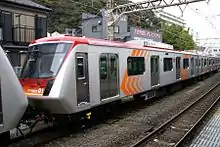Tokyu 6000 series
The Tokyu 6000 series (東急6000系, Tōkyū 6000-kei) is an electrical multiple unit (EMU) train type operated by the private railway operator Tokyu Corporation on express services on the Tokyu Oimachi Line in Japan since 28 March 2008. Based on the 5000 series design, cars have four sets of doors per side with a more aerodynamic front end design than its predecessors.[1]
| Tokyu 6000 series | |
|---|---|
_Express_20180319.jpg.webp) A 6000 series set on an express service in March 2018 | |
| Manufacturer | Tokyu Car Corporation, J-TREC |
| Built at | Yokohama |
| Constructed | 2007–2017 |
| Entered service | 28 March 2008 |
| Number built | 42 vehicles (6 sets) |
| Number in service | 42 vehicles (6 sets) |
| Formation | 7 cars per trainset |
| Fleet numbers | 6101–6106 |
| Operator(s) | Tokyu Corporation |
| Line(s) served | Tokyu Oimachi Line |
| Specifications | |
| Car body construction | Stainless steel |
| Car length | 20,435 mm (67 ft 1⁄2 in) (end cars) 20,000 mm (65 ft 7 3⁄8 in) (intermediate cars) |
| Width | 2,800 mm (9 ft 2 1⁄4 in) |
| Height | 3,640 mm (11 ft 11 1⁄4 in) |
| Doors | 4 pairs per side |
| Maximum speed | Service: 110 km/h (70 mph) Design: 120 km/h (75 mph) |
| Traction system | Variable frequency (2-level IGBT) |
| Power output | 190 kW (250 hp) x 6 |
| Acceleration | 3.3 km/(h⋅s) (2.1 mph/s) |
| Deceleration | 3.5 km/(h⋅s) (2.2 mph/s) (service) 4.5 km/(h⋅s) (2.8 mph/s) (emergency) |
| Electric system(s) | 1,500 V DC Overhead wire |
| Current collection method | Pantograph |
| Safety system(s) | ATC-P, CS-ATC |
| Track gauge | 1,067 mm (3 ft 6 in) |
Formation
As of 1 April 2017, the fleet consists of six seven-car sets, numbered 6101 to 6106 and formed as follows, with three motored (M) cars and three trailer (T) cars, and car 1 at the Oimachi end.[2][3]
| Car No. | 1 | 2 | 3 | 4 | 5 | 6 |
|---|---|---|---|---|---|---|
| Designation | Tc2 | M | T | M2 | M1 | Tc1 |
| Numbering | 6100 | 6200 | 6300 | 6400 | 6500 | 6600 |
| Weight (t) | 26.9 | 30.7 | 28.2 | 33.3 | 32.9 | 26.8 |
| Capacity (total/seated) | 139/48 | 150/51 | 150/54 | 150/54 | 150/51 | 139/48 |
Car 5 is fitted with two single-arm pantographs, and car 2 is fitted with one.[3]
Interior
Passenger accommodation consists of longitudinal bench seating throughout, with a seat width of 460 mm (18 1⁄8 in) per person.[3] Wheelchair spaces are provided at the ends of cars 2 and 5.[3]
 Interior view in March 2008
Interior view in March 2008 7-person longitudinal bench seat in March 2008
7-person longitudinal bench seat in March 2008 Priority seating in March 2008
Priority seating in March 2008
History

The first set, 6101, was delivered in December 2007.[4] The first trains entered revenue-earning service on 28 March 2008.[5]
Six new DeHa 6300 intermediate cars were delivered from the J-TREC factory in Yokohama in August 2017.[6] These will be used to lengthen the fleet of six trainsets to seven cars each between November 2017 and March 2018.
References
- 私鉄車両年鑑2013 [Japan Private Railways Annual 2013] (in Japanese). Tokyo, Japan: Ikaros Publications Ltd. 20 March 2013. p. 177. ISBN 978-4-86320-693-9.
- 私鉄車両編成表 2017 [Private Railway Rolling Stock Formations - 2017] (in Japanese). Japan: Kotsu Shimbunsha. 25 July 2017. p. 63. ISBN 978-4-330-81317-2.
- 東京急行電鉄6000系 [Tokyu 6000 series]. Japan Railfan Magazine (in Japanese). Vol. 48 no. 564. Japan: Koyusha Co., Ltd. April 2008. pp. 67–74.
- 甲種鉄道車両輸送計画表 [New Rolling Stock Delivery Schedule]. Tetsudō Daiya Jōhō Magazine. Vol. 37 no. 285. Japan: Kotsu Shimbun. January 2008. p. 124.
- 3月28日、大井町線の急行運転を開始、田園都市線の混雑緩和を目指します [Oimachi Line express services to commence on 28 March, and aiming to alleviate overcrowding on Denentoshi Line] (PDF). News release (in Japanese). Japan: Tokyu Corporation. 15 February 2008. Archived from the original (PDF) on 22 July 2011. Retrieved 18 August 2017.
- 東急6000系中間車が甲種輸送される [Tokyu 6000 series intermediate cars delivered]. Japan Railfan Magazine Online (in Japanese). Japan: Koyusha Co., Ltd. 30 August 2017. Archived from the original on 31 August 2017. Retrieved 30 August 2017.
External links
| Wikimedia Commons has media related to Tokyu 6000 series. |
- Tokyu EMU details (in Japanese)
- Tokyu 6000 series (Japan Railfan Magazine) (in Japanese)
